Do your eyes feel red, dry, or tired after long gaming sessions? Eye strain from video games occurs due to too much blue light exposure, screen glare, and poor lighting around you.
This guide will teach you how to reduce eye strain while gaming by making simple changes to your setup and habits. Read on for six easy tips that protect your vision and boost your gameplay.
Key Takeaways
Gaming for hours without breaks causes digital eye strain such as dry eyes, blurred vision, headaches and poor sleep; about 90% of computer users face these issues (Computer Vision Syndrome or CVS).
Simple changes like following the “20-20-20” rule (look at something 20 feet away every 20 minutes for 20 seconds), blinking often to keep eyes moist, enabling low blue-light modes (e.g., Windows Night Light), and adjusting screen brightness and contrast can greatly reduce eye discomfort.
Keeping screens approximately 24 inches from your face at around 15–20 degrees below eye level, using anti-glare filters or monitor light bars with adjustable color temperature (such as BenQ ScreenBar or Quntis Computer Monitor Lamp), can help limit harmful blue-light exposure and reflections that tire out your eyes quickly.
Proper room lighting matters: experts recommend a brightness ratio of roughly 1:3:10 between your gaming monitor, desk objects nearby, and background area to minimize glare stress on visual muscles when gaming.
Wearing special protective glasses like Livho High Tech Blue Light Glasses blocks up to 99% blue light radiation; gamers report feeling noticeably less tiredness in their eyes during long play times.
Table of Contents
Symptoms and Causes of Eye Strain While Gaming

If you game for hours, your eyes might feel dry or blurry from staring at a bright screen. Blue-light exposure and constant eye movements can tire the eyes, making gaming less comfy over time.
Signs of Digital Eye Strain
Playing video games for hours strains the human eyes. Around 90% of computer users experience digital eye strain, also known as Computer Vision Syndrome (CVS).
- Red or dry eyes: Gamers often stare at screens without blinking much. The normal blinking rate is about 20 blinks per minute, but this drops to only 5-10 during intense gaming sessions. Fewer blinks leave your eyeballs dry and irritated, causing redness and discomfort.
- Blurred vision: Constant screen time makes extraocular muscles tired, especially the ciliary muscles that focus the lens inside your eyes. These tired muscles lead to temporary blurred vision after long gaming periods.
- Headaches and fatigue: Tension in eye sockets and surrounding muscles may trigger headaches after a few hours of gaming. Bright illumination from screens combined with squinting causes muscle stress around the forehead and temples.
- Sensitivity to light: Long exposure to bright color temperatures on screens can increase sensitivity to ambient light later on. Eyeballs become overly sensitive outdoors or even in rooms with regular indoor lights.
- Trouble concentrating: Eyestrain from prolonged screen brightness may make it hard to focus clearly afterward; your eyes feel jumpy trying to follow movements of the eyes smoothly across text or images away from gaming.
- Interrupted sleep patterns: Blue-light from screens disrupts melatonin production, a hormone essential for good sleep quality; late-night gaming can mean trouble falling asleep afterward.
Yesterday, after reading several iGaming reviews, I realized how important it is to take good care of my eyes while enjoying digital activities. This inspired me to explore some useful insights about common causes of gamer eye strain and ways we can protect ourselves, detailed below.
Common Causes for Gamers
Digital eye strain signs are common for gamers, but knowing their causes can help you beat them. Check out these frequent factors that put strain on gamers’ vision:
- Extended screen use is a main cause of digital eye strain; sessions lasting hours without breaks tire the superior rectus and lateral rectus—two key muscles of the eyes—and lead to blurred vision.
- Poor screen brightness and contrast settings force your pupils to change size often, causing your iris’ radial muscles to fatigue and leading to headaches or double vision.
- Insufficient blinking during intense gaming dries out the tear layer over your eyeballs, resulting in red eyes or chronic eye dryness that may need artificial tears or eye drops.
- Wrong viewing distance from your monitor affects how hard the medial rectus and inferior oblique muscles have to work; sitting too close or too far away creates additional stress on these intraocular muscles, especially during smooth pursuit tasks common in action games.
- Blue light from screens has short visible light wavelengths that disrupt sleep cycles and increase oxidative stress inside your eyes; this extra strain can worsen myopia (nearsightedness) symptoms over prolonged gaming sessions.
- High refresh rates and frame rate mismatches sometimes result in screen tearing; this visual glitch adds extra load on your visual acuity, making eye fatigue more likely after long gaming periods.
- Poor lighting around your gaming setup optimization creates harsh contrasts between bright screens and dark backgrounds; this problem wears down palpebral structures including eyelids and orbicularis oculi muscle tissues faster than normal lighting would.
- Wearing outdated eyeglasses or incorrect contact lens prescriptions while playing games strains inferior rectus and superior oblique muscles further by forcing them into constant focus adjustments, leading quickly to sore eyes or even mild amblyopia (“lazy eye”) symptoms if left unchecked for weeks or months at a time.
- Virtual reality (VR) headsets require rapid adduction and abduction movements from multiple ocular muscles like superior oblique and lateral rectus; extended VR gameplay increases chances of developing visual discomfort due to intense demands placed on these muscle groups without enough rest periods between uses.
Screen Adjustments to Reduce Eye Strain
Fine-tuning your on-screen display settings can make gaming less stressful on your eyes. A good light filter or anti-glare screen helps block harsh blue hues from the visible light spectrum, easing digital eye strain.
Adjust Screen Brightness and Contrast

Adjust your gaming monitor’s brightness to match your room lighting. If the screen seems like a lamp, you’re tiring your eyes fast and risking vision problems. Raise the contrast settings through the on-screen display to sharpen text clarity; clear letters mean less eye fatigue over time.
From my own use of virtual reality gear, finding this sweet spot helps lessen headaches and dry eye disease during long sessions. Keep the screen about 24 inches away, tilted 15-20 degrees below your palpebrae (eyelids).
Set text size three times larger than what’s barely readable at that distance for best comfort.
Your eyes are precious tools—protecting them starts with smart screen adjustments.
Next up is enabling low blue-light modes on your device settings.
Enable Low Blue Light Modes
Blue light from screens can harm your eyes, disrupt sleep, and damage brain function over time. Many monitors now have low blue light modes built-in to reduce these risks. Windows 10 and Windows 11 offer the Night Light feature, a quick and easy fix that cuts harmful blue light without hurting image quality or gaming visuals.
High-quality monitors also use advanced blue-light filter technology for safer viewing, though these can cost more due to complex production methods.
Gamers who spend hours online face higher risk of digital eye strain; activating low blue light filters is simple self-care for healthier vision during long sessions. As someone who has used Night Light on late-night raids or marathon runs through Elden Ring myself, I noticed fewer headaches and better rest afterward.
If you prefer eyewear solutions as backup protection against harmful UV radiation too—whether in contact lenses with built-in UV filters or shades like Gunnar Optiks glasses—that combo offers extra defense alongside software settings alone.
Use Anti-Glare Coatings or Screens
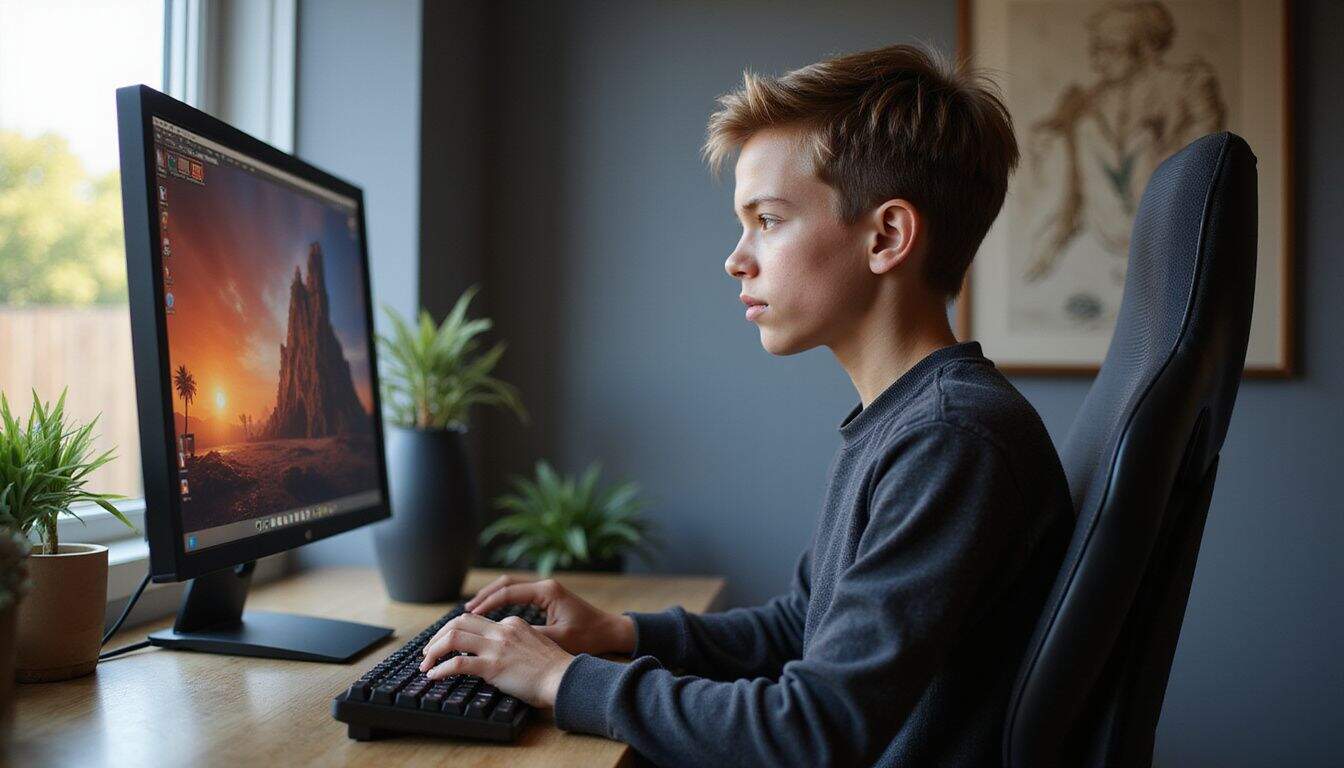 Anti-glare filters can greatly improve your comfort during long gaming sessions by cutting down annoying screen glare. They work by reducing harsh reflections and scattering intense light waves that lead to digital eye strain.
Anti-glare filters can greatly improve your comfort during long gaming sessions by cutting down annoying screen glare. They work by reducing harsh reflections and scattering intense light waves that lead to digital eye strain.
For example, a matte anti-glare screen on your gaming monitor can soften the brightness impact from strong indoor lighting or sunlight through windows. From first-hand experience, switching to an anti-glare coating made playing fast-paced shooters easier on the eyes after hours of gameplay.
Gamers who often stream playthroughs via Facebook or other parts of the internet will find these screens helpful as well, since streaming rooms usually require bright lights for clear camera shots.
Anti-reflective coatings also slightly boost sharpness and contrast perception without raising brightness levels that aggravate UV light exposure risks or cause dry contacts irritation while staring at your display.
With less glare hitting your eyes directly, you won’t just feel more comfortable; you’ll likely rack up higher oxygen radical absorbance capacity (ORAC values) naturally because reduced strain means healthier eyesight overall.
Optimizing Your Gaming Environment is another key step toward keeping your vision clear and fresh during extended game time.
Tips for Maintaining Healthy Gaming Habits
Eye exercises and simple adjustments can make your gaming time healthier for your eyes. Small changes in habits protect you from dry eyes, blurred vision, and even headaches later on.
Follow the 20-20-20 Rule
The 20-20-20 rule guards your eyes against strain during gaming. It means every 20 minutes, you take a small break and look at something about 20 feet away for around 20 seconds; metric users call this the “20-6-20” rule (every 20 minutes, stare at an object that’s roughly 6 meters away for at least 20 seconds).
From first-hand experience, I found it helpful to follow this rule while using eye exercises or vision therapy apps on breaks. Practicing it daily may prevent digital eye strain symptoms like blurred vision and headaches during gameplay, helping you prepare for a long gaming session.
Healthy eyes mean better games—take visual breaks seriously!
Blink Frequently to Prevent Dry Eyes
Your eyes blink around 20 times every minute, but during intense gaming sessions, this can drop down to just 5-10 blinks per minute. Low blinking rates cause dry eyes; your tears evaporate faster and discomfort kicks in.
Frequent blinks keep your eyes wet and reduce digital eye strain symptoms like redness and irritation. Pausing briefly to perform quick eye exercises every 30-60 minutes helps as well.
Near-to-far focus drills or smooth pursuit exercises refresh tired eye muscles, lowering the risk of severe dry-eye issues that could lead to more serious diagnoses later on.
Take Regular Breaks During Gaming Sessions
Experts suggest taking breaks every 40 to 50 minutes during long gaming sessions. Short pauses protect your eyes and body from strain, digital eye fatigue, and risks like deep vein thrombosis (DVT).
Every 20 to 30 minutes, step away for at least five minutes; stand up, stretch your legs, or look into the distance while blinking often. Another good trick is “blink breaks.” Close your eyes gently for three seconds every five to ten minutes and repeat this action about five times.
These quick rests refresh eyesight and prevent dry eye symptoms without sacrificing precious game progress or analytics data tracking through cookies; targeted advertising can still gather illuminating insights as you pause briefly between rounds.
Optimizing Your Gaming Environment
Your gaming space and gear setup affect your comfort—proper lighting, smart furniture choices, and clear screen positions matter; read on to level up your gaming room for healthier eyes.
Set Up Proper Lighting to Minimize Glare
Proper lighting cuts down glare and keeps eyes relaxed during long gaming hours. Light up your gaming space at around 500 lux brightness for best comfort, as suggested by the Illuminating Engineering Society.
They advise using a brightness ratio of 1:3:10 between the monitor, nearby desk items, and background surroundings to ease eye strain. Monitor light bars help more than desk lamps because they produce wider coverage without hogging valuable space; many also have adjustable color temperature settings.
Some gamers even add fish oil to their routine after getting an official diagnosis of dry-eye issues related to screen use.
Good lighting equals good gaming—take care of your eyes.
Maintain an Ergonomic Setup
Good lighting helps lower glare, but your body needs a comfy spot too. Set your gaming monitor 15-20 degrees below eye level; this puts less stress on your eyes and neck. Keep screens around 24 inches away from you to maintain an easy focal distance.
Most ergonomic monitors offer height, tilt, swivel, and pivot controls for simple adjustments; tweak these often until you feel relaxed. From my personal setup, adjusting text size three times larger than the smallest readable font at my sitting distance made long gaming sessions much easier on the eyes and posture alike.
Tools and Technology to Help Reduce Eye Strain

Today’s gaming tech offers comfortable gear and smart settings to keep your eyes healthy—read on to see what’s new.
Blue Light Glasses
Blue light glasses, like Livho High Tech Blue Light Glasses, block 99% of harmful blue light. They reduce eye strain and fatigue from long hours spent gaming or working at screens.
These glasses have a stylish frame design that looks great for both work tasks and gaming sessions.
Gamers who use these glasses report less tiredness in their eyes during extended playtime. Wearing these special lenses helps you game comfortably over longer periods without dry or achy eyes spoiling your fun.
Monitor Light Bars with Adjustable Color Temperature
Monitor light bars are handy additions to your gaming setup. Devices like the BenQ ScreenBar come with up to 15 brightness levels, 8 different color temperature settings, and eye protection technology.
It features 78 high-quality LED beads for even lighting and a Color Rendering Index as high as Ra98, ensuring colors look natural without glare or harsh edges. Another solid choice is the Quntis Computer Monitor Lamp that lets you switch color temperatures from warm yellows at 3000K to cool whites at 6500K depending on your preference and comfort level.
Adjusting between warm or cool lights reduces eye strain during long sessions, making these tools smart upgrades for serious gamers.
As tech advances quickly, how might gaming impact our eyes in the future?
How Will Gaming and Eye Strain Prevention Evolve in 2025?
In 2025, gaming setups will feature advanced lighting tech to ease strain on gamers’ eyes. Adjustable screen light bars, like the BenQ ScreenBar, will reduce glare and limit blue light exposure for safer sessions.
Smart brightness systems that keep balanced ratios between screens and room lights will become essential tools. Regular breaks using methods such as the 20-20-20 rule, low-blue-light filters, and ergonomic gear setups are likely to stay key habits.
At the same time, deeper knowledge of how eye muscles work—both inside and outside of your eyes—will lead to better ways of preventing fatigue during long games. Gamers who grasp this anatomy knowledge early can tweak their setup well enough to protect their vision effectively during intense play periods.
New software tools may also offer alerts or guided reminders for taking short rests based on your gaming patterns; these digital helpers will make it easy and natural to maintain healthy eyesight while still leveling up in favorite titles.
People Also Ask
Why do my eyes feel tired after gaming for a long time?
Your eyes get strained from staring at screens too long without breaks, causing dryness and discomfort. To reduce eye strain while gaming, take short breaks often to rest your eyes.
How can adjusting screen brightness help prevent eye strain during gaming?
Lowering the brightness level of your screen reduces glare and eases stress on your eyes. Adjust it so it’s not too bright or too dim; find a comfortable setting that matches the room lighting.
Does sitting farther away from the monitor really help protect my eyesight when I game?
Yes, keeping some distance between you and your monitor helps lessen eye fatigue by reducing exposure to intense light and blue rays emitted by screens. Sit about an arm’s length away for best results.
Can special glasses actually reduce eye strain caused by video games?
Gaming glasses with lenses designed to filter out harmful blue light can ease visual discomfort and improve focus during gameplay sessions. They also help keep your vision clear over longer periods of playtime.
References
https://www.cedars-sinai.org/health-library/diseases-and-conditions/c/computer-vision-syndrome.html
https://www.benq.com/en-us/knowledge-center/knowledge/reduce-eye-strain.html
https://www.aao.org/eye-health/tips-prevention/computer-usage
https://www.hp.com/us-en/shop/tech-takes/reducing-blue-light-on-your-pc-screen
https://www.healthline.com/health/eye-health/20-20-20-rule
https://saratogavision.com/digital-eye-strain-tips-for-protecting-your-eyes-in-the-digital-age/
https://www.basonlight.com/blogs/article/lighting-tips-reducing-eye-strain-extended-gaming-sessions
https://www.amazon.com/Blocking-Glasses-Computer-Reading-Eyestrain/dp/B07W781XWF
https://www.amazon.com/Quntis-Computer-Reading-Auto-Dimming-Adjustment/dp/B08DKQ3JG1
https://riverheightseyecare.com/how-to-reduce-eye-strain-while-gaming/
